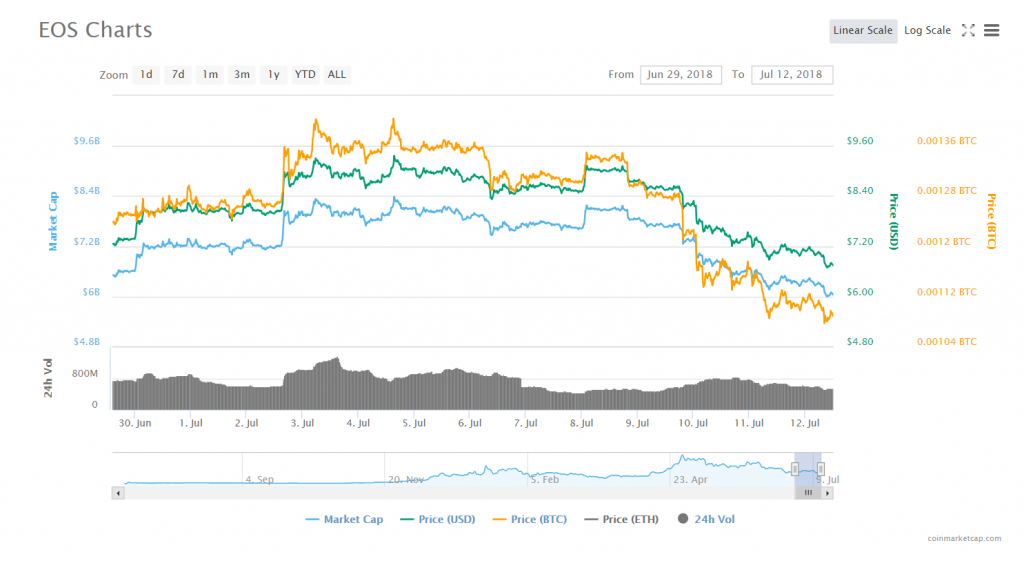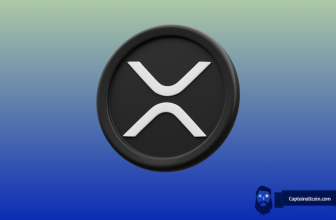
EOS has fallen off significantly in the last couple of days. Starting July 8th just above $9 USD it has since went on a continual bleed which saw the price reach its current levels of $6,74 USD. Expectedly, EOS/BTC ratio dropped somewhat slower as the price went from 134455 to 109446 satoshi where it sits right now. The coin’s EOS/USD ratio has suffered a 5,22% drop in the last 24 hours, and the coins market cap of $6,018,163,607 USD leaves it comfortably as the no.5 most valuable cryptocurrency in the world.

However this might not be all we saw from the coin, as analysts feel that a key support at $7 USD has been broken. As a result, EOS might be looking to drop even further to its early April levels of $5 USD.
FA side of things supports the negative price movement, as EOS is still struggling in its post-mainnet launch days. The token migration is apparently still ongoing, according to coinmarketcap.com. With all those in mind, RAM issues are taking over almost every discussion about the project.
The issue with EOS RAM trading has been one we saw with various resources in the crypto space: early investors bought the resource for pennies, then the demand for the resource started rising which caused the price to rise as well. As the price kept going up, people started FOMOing in and buying it just to profit from trading and speculation. This went on until big holders decided they’ve had enough and decided to dump their holdings onto inexperienced traders and FOMOers.
RAM problems continued on July 7th when several block producers crashed due to a “failure to adjust a default configuration on a plugin in their producing code”. The mainnet remained operational, as at least 18 BP’s weren’t affected by the issue. Standby nodes replaced the producers who unregistered after they crashed. Several solutions have been suggested so far and improvements in the technology, economy and community aspects of the project will be required for the RAM issue to be fully resolved.
Recently we also saw a problem with a secret key generation tool which exposed several users to “rainbow” attacks, theft of private keys and loss of funds. PeckShield, a blockchain security company, wrote about the issue:
“The essence of the risk is caused by an improper use of third-party EOS key-pair generation tools, including but not limited to EOSTEA. With user-provided seeds, these tools greatly facilitate users to generate their EOS key pairs. Unfortunately, if a simple seed is chosen (by the user) and allowed (by the tool), the generated keys might be exposed and exploited by launching the rainbow table attack (or dictionary attack).”
However, this report turned out to be somewhat overblown and not a fault of EOS themselves, as RancorOnRye from Reddit points out:
“Why does everybody want to jump on a band wagon instead of contributing to the discussion? This has nothing to do with EOS as a platform. This is stupid users making bad decisions on random third party software that MAY open them up to attacks. You ever try and make a shitty password on a site but it stops you saying it’s too shitty? That’s what is happening here except nobody is stopping them from doing it. This is PeakShield just advertising with no sustenance.”
Meanwhile, EOS bug bounty program was reported to have paid out over $348 thousand USD since the platform announced its cooperation with HackerOne at the start of June. Bug bounty programs are envisioned as testing grounds for platforms which let developers and “hackers” look into code and basically find flaws in it. EOS bounty has predicted quality awards ranging from $5,000 to $10,000 for finding critical bugs. Finding lower significance bugs is awarded with payments ranging from $100 to $5,000. Since the program’s inception, community found 42 bugs of various severity and received a total of mentioned $348 thousand USD for their findings.
For now, the project remains operational; its holders had additional reasons to be happy as Everipedia, an EOS-based platform, started delivering airdrops. It will be interesting to see when (if) EOS will recover from its initial launching pains and effects of the bearish market movements that are currently plaguing the entire cryptosphere.







